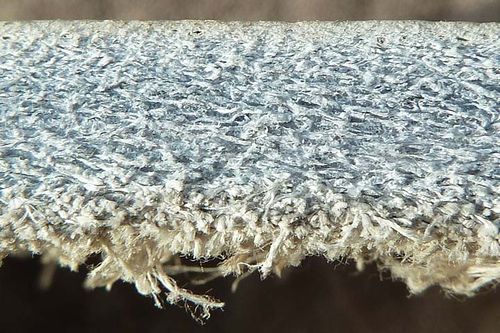Widening shoes
New shoes or boots can be too tight, causing painful pressure points or bubbles. Therefore, the question often arises whether and how the leather can be softened or stretched.
Footwear upper leather is made of solid, thick cowhide leather. Therefore, there is only limited scope to soften and win surface by stretching. Under a microscope, leather is a fibre braid. One gram of leather has an internal surface of up to 300 m², since its fine fibres are strongly interlinked. Thus, leather has a high resistance to tearing and bending.
Leather in cross-section. The fibre structure is extremely dense and therefore stable.
Stretching shoes and liquid shoes stretch spray
Tanners and shoemakers uses various tools and methods to make this fibre braid more flexible or softer.
The fibre braid can be loosened by stretching. The tanner does this by using a staking machine. The shoemaker has several options. By machinery, tools and knocking, the fibre structures is stretched or torn microscopically, and the leather becomes softer and gains some surface. As long as this is done professionally, the necessary stability of the leather is maintained.
In addition, the moistening is helpful to the stretching. Moistening the leather softens and swells the fibre braid and can then deform the leather more easily and more permanently.
A shoemaker explains the possibility of leather stretching in shoes and boots.
Therefore, there are several ways to make shoe leather softer:
In case of shoes which only lightly press, the shoes should be used. It is best to walk about 1 hour with the shoes and try again. Wear thick socks to support the stretching. But not too thick. Otherwise the leather could be overstretched and the shoe becomes too big.
The moistening of the socks is often recommended. Due to the moistening, the leather is additionally pre-softened and is then easier to deform. But beware! Too much moisture can cause stains!
Shoes can be painfully tight.
There are many myths about the "moistening". For example, it is recommended to "pee" into the shoes or boots. In the forums, also alcohol, shoe shine sprays from specialist retailers, special oils and many other liquids are recommended. The rumour that urine is particularly good is wrong. Every moistening makes leather softer. "Water" would always be better than urine. Alcohol is not suitable at all because leather fats get dissolved by alcohol and the leather loses its suppleness.
Never dry too hot! Do not put wet shoes on the heater. As a result of the heating, the fibre braid sticks and the leather becomes hard and can shrink at too high temperatures. The fibre braid can then only be loosened again by a strong expenditure of force, and the fibre structure suffers thereby.
New is the idea of placing a plastic bag in the shoe that is filled with water. This then comes into the freezer compartment. By the expansion of the water during the transformation into solid ice, strong pressure is exerted on the upper material of the shoe. This idea comes from the online mail order business, which wants to significantly reduce its return rate.
Stretching of shoes using the freezing method.
The described methods only work when the leather is lightly pressing. Definitely too tight shoes or with completely wrong fit cannot be saved. Then the leather can even tear through the use of force to get it softer and expanded. Heat should not be used because too high heat shrinks leather.
Additional information










 a kotori web solution
a kotori web solution